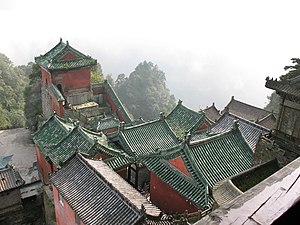One of the most important aspects of health and longevity of your body is regular activity. Through daily stretching, you can not only keep your body healthy, but also protect yourself from injuries in the future. But the internal method of stretching differs greatly from the aggressive and westernized stretching methods. Of course, there are the horror stories of gongfu students and sumo wrestlers in forced stretches, but to do natural and healthy stretching, there is no fast track.
The first point I want to cover with everyone attending classes, is the idea that all stretches should be done while standing. This includes crouching, leaning, and even hanging. But it is important to keep in mind that stretches done while sitting on the ground or laying down may not be as practical as their standing counterparts. Of course you cannot expect to get as deep or "extreme" of a stretch. But what this means is that the applicable connecting ligaments, muscles, and joints aren't getting the appropriate stretch while sitting. This is how extremely flexible people can still suffer injuries of pulled muscles. Finding standing versions of all your stretches will help make sure the flexibility is translatable to your art.
Because stretching is a long process, you have to constantly remember to repeat. Mix up the method each time you stretch. You may have your leg up on a bar, and lean into it, but there are hundreds of angles and tweaks you can do to this to ensure complete flexibility. The direction of your supporting foot, the bend in your supporting knee, the direction and balance in your hips, the part of your back which pulls towards the leg, the direction of the knee on the raised leg, reach with the same side arm, reach with the cross body arm, etc. etc. etc.
Some arts say to constantly bounce while stretching. Other say hold the stretch. I believe that mixing the two is the most promising. By bouncing, you build a comfort in the rubbery and springiness of the muscles, while holding creates an overall increased range. Switch back and forth. If something feels tight and uncomfortable, bounce a small bit--increasingly--before doing a deep stretch. After the deep stretch, bounce a bit to get a little comfort right past your limit. These will help protect the body, and increase it's comfort under the stresses of training.
Core training while stretching is also an excellent tool. As a warning, the idea behind the internal method of strengthening and conditioning is to only hold the posture or stress the body for as long as the muscles necessary can stay relaxed. If you find yourself tensing and holding in the hips, shoulders, thighs, back, arms, neck, etc. then it is time to relax, breathe, and recover. Find your stretch, put yourself into it, then find a way to relax every part of your body while you're there. Since stretches are done standing or upright, relax into this and hold it as a standing meditation. Maintain this until you find the holding or shakes come on, then relax again.
Stretching, just as your drilling and training, is limited and expanded only by the amount of effort one puts in. There is not right quantity or wrong quantity of stretches, time spent stretching, or depth to stretches. Just feel it through, and decide when enough is enough. The more often and the more effort is the gongfu for more return. But it is up to each person to decide how much effort and time they wish to put into stretching, strengthening, conditioning, drilling, and training. It is an individual path and journey. There is not place along it which can be compared to the people around you.
On a personal note, I feel I neglect my own stretching, and I regret it every time I train. I look back at my youth training, and frown upon the lack of time I spent working towards healthy and extreme flexibility when it came so easy to me. And now, the older I get, the harder it gets to gain back what I had missed out on in my youth. Every kick I throw, and every twist I turn: I remember the lack of discipline and patience I had in my division of training time. Please, consider giving ample and generous amounts of your personal training time towards stretching.
I know in class I tend to cut stretching short at 10-15 minutes (hiding under the excuse that if you want a good stretch, show up early), but in truth, is is not enough time to truly stretch all the muscles and angles you will be using them in. I never will hold it against a student who wishes to keep stretching when class moves on. But do consider showing up early for serious stretching time.
Overall, the idea behind this article is that you should stretch in the way you train. You should stretch while practicing relaxation of the external muscles. You should stretch in the positions you will be utilizing. If you find a position or a reach, or a body configuration limiting, that's a new way to stretch. Just keep in mind proper joint alignment, and if you feel any pains outside of your stretch, avoid that specific stretch until your next class.
Best of Wishes in all your ventures & training!
~Instructor Michael A. Vollero (夏逍鵬)
Read more...





![Reblog this post [with Zemanta]](http://img.zemanta.com/reblog_c.png?x-id=0dedf69e-3e81-4bca-a3f7-4d3159bc792a)
![Reblog this post [with Zemanta]](http://img.zemanta.com/reblog_c.png?x-id=f12e8358-45fb-4419-89e6-b3863ca24058)





![Reblog this post [with Zemanta]](http://img.zemanta.com/reblog_c.png?x-id=89a81141-1bc2-4737-890f-a89bc2fbf8c2)

![Reblog this post [with Zemanta]](http://img.zemanta.com/reblog_c.png?x-id=db2b971e-9cef-4dee-8418-6cfa81db462f)
![Reblog this post [with Zemanta]](http://img.zemanta.com/reblog_e.png?x-id=a431e403-a8be-4f0f-9212-83683e4349b4)
![Reblog this post [with Zemanta]](http://img.zemanta.com/reblog_c.png?x-id=3b02c561-7c10-46a4-8453-d357f12b1c7d)



